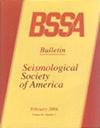用大地形变的粘弹性地震周期模拟求解南卡斯卡迪亚断层的滑动亏缺率
IF 2.9
3区 地球科学
Q2 GEOCHEMISTRY & GEOPHYSICS
引用次数: 0
摘要
南卡斯卡迪亚俯冲带(CSZ)的前弧,门多西诺三联结(MTJ)的北部,是第四纪活跃的地壳断层网络的所在地,由于北美、胡安·德·富卡(戈达)和太平洋板块的相互作用,这些断层积累了压力。这些断层,包括小鲑鱼断层和Mad River断层(LSF和MRF)带,位于加利福尼亚北部海岸人口最密集的地区附近,在过去1700年里显示了三次几米尺度的滑动事件的古地震证据。然而,这些断层的大地测量滑动率很少受到约束。在这项工作中,我们分析了来自全球导航卫星系统的地震间大地速度汇编,以及MTJ附近的水准和潮汐测量数据,以约束当前上板块断层的滑动亏缺率和大型逆冲断层的耦合。本文构造了粘弹性地幔上弹性板块内离散断层的地震间滑动亏缺格林函数。然后,我们使用约束最小二乘反演来确定主要断层上的最佳拟合滑动率,并研究断层之间的滑动率权衡。结果表明,LSF和MRF系统共同积累4-5 mm/yr的反滑移亏损,尽管它们各自的滑移率不能独立确定。水平和垂直速度的模拟表明,最南端的CSZ与深度超过25公里的地震间耦合。我们还发现,6-17 mm/年的右侧滑动亏损延伸至MTJ以北并进入卡斯卡迪亚弧前南部。这些结果强化了这样一种观点,即卡斯卡迪亚最南端的巨型逆冲断层及其上方较小的弧前断层都是造成区域地震危险的原因。本文章由计算机程序翻译,如有差异,请以英文原文为准。
Slip Deficit Rates on Southern Cascadia Faults Resolved with Viscoelastic Earthquake Cycle Modeling of Geodetic Deformation
The fore-arc of the southern Cascadia subduction zone (CSZ), north of the Mendocino triple junction (MTJ), is home to a network of Quaternary-active crustal faults that accumulate strain due to the interaction of the North American, Juan de Fuca (Gorda), and Pacific plates. These faults, including the Little Salmon and Mad River fault (LSF and MRF) zones, are located near the most populated parts of California’s north coast and show paleoseismic evidence for three slip events of several-meter scale in the past 1700 yr. However, the geodetic slip rates of these faults are poorly constrained. In this work, we analyze a new compilation of interseismic geodetic velocities from Global Navigation Satellite Systems, leveling, and tide gauge data near the MTJ to constrain present-day slip deficit rates on upper-plate faults and coupling on the megathrust. We construct Green’s functions for interseismic slip deficit for discrete faults embedded in an elastic plate overlying a viscoelastic mantle. We then use a constrained least-squares inversion to determine best-fitting slip rates on the major faults and investigate slip rate trade-offs between faults. Results indicate that the LSF and MRF systems together accumulate 4–5 mm/yr of reverse-slip deficit, although their separate slip rates cannot be determined independently. Modeling of the horizontal and vertical velocities suggests that the southernmost CSZ is coupled interseismically to deeper than 25 km depth. We also find that 6–17 mm/yr of right-lateral slip deficit extends north of the MTJ and into the southern Cascadia fore-arc. These results reinforce the notion that both the southernmost Cascadia megathrust and the smaller fore-arc faults above it contribute to regional seismic hazard.
求助全文
通过发布文献求助,成功后即可免费获取论文全文。
去求助
来源期刊

Bulletin of the Seismological Society of America
地学-地球化学与地球物理
CiteScore
5.80
自引率
13.30%
发文量
140
审稿时长
3 months
期刊介绍:
The Bulletin of the Seismological Society of America, commonly referred to as BSSA, (ISSN 0037-1106) is the premier journal of advanced research in earthquake seismology and related disciplines. It first appeared in 1911 and became a bimonthly in 1963. Each issue is composed of scientific papers on the various aspects of seismology, including investigation of specific earthquakes, theoretical and observational studies of seismic waves, inverse methods for determining the structure of the Earth or the dynamics of the earthquake source, seismometry, earthquake hazard and risk estimation, seismotectonics, and earthquake engineering. Special issues focus on important earthquakes or rapidly changing topics in seismology. BSSA is published by the Seismological Society of America.
 求助内容:
求助内容: 应助结果提醒方式:
应助结果提醒方式:


